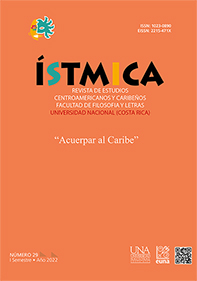Black and white, skin and masks, the body in Caribbean art. Readings from Frantz Fanon
DOI:
https://doi.org/10.15359/istmica.29.5Keywords:
Caribbean, visual arts, raciality, body, decolonialityAbstract
Black and white are more than colors, they are keys to a symbolic contrast on islands that built their social structure –since colonial times– on slavery that racialized social relations and generated with them various forms of discrimination that continue to this day. One of the important contributions of black to the visual arts of the Caribbean is its color, a visual sign in the universe of racial tensions, born in the very heart of modern–colonial society. This work aims to distinguish that trajectory of visual meanings, through a selection of works that use black and white from the physical support of the body with all its expressive capacities. One of the most significant texts of the twentieth century on the issue, Black Skin, White Masks (1952) by Frantz Fanon, will be assumed as a resource of critical interpretation for the study of the selection of works and authors from the insular Caribbean that are inscribed in the conflicts of the
racialization and inferiorization of corporeality, to explore forms of a decolonizing humanism, "to return man to his place", to reposition his "I" and to revalue his place in history.
References
Andrade Jaramillo, Marcos “El Código Negro de Francia y la Jurisdicción Indígena Latinoamericana” Mañogo Nº 18, (2002), 77–87. http://servicio.bc.uc.
edu.ve/postgrado/manongo18/18–5.pdf (consultado 15 de julio 2021).
Castro–Gómez, Santiago y Ramón Grosfoguel, “Prólogo” en El giro decolonial: reflexiones para una diversidad epistémica más allá del capitalismo global.
Comp. Santiago Castro–Gómez y Ramón Grosfoguel (Bogotá: Siglo del Hombre Editores; Universidad Central, Instituto de Estudios Sociales Contemporáneos y Pontificia Universidad Javeriana, Instituto Pensar, 2007).
Domínguez, Asdrúbal. “Novias para Ogún en La Galería”. Santo Domingo: Isla Abierta. Sábado 4 de enero de 1986 s/p.
Fanon, Frantz. Piel negra, máscara blanca. Argentina: Ed. Abraxas. 1973.
Gordon, Lewis R. <>. En Frantz Fanon. Piel negra, máscaras blancas (España: Ed. Akal, España, 2009) 217–59.
Hese, Philippe. “Le code noir: de l’homme et de l’esclavage”. Actes du colloque international sur la traite des noirs Del traite á l’esclavage du XVIII eme au XIX siécle. Nantes: Universidad de Nantes, 1988.
Marinello, Juan. “Ante los cuadros de Peñita”. Comentarios al arte. Cuba: Ed. Letras Cubanas, 1983.
Métraux, Alfred. Le Vaudou Haïtien París: Gallimard. 1959.
Planson, Claude. “Vaudou, un initié parle”, s/p.
Wood, Yolanda. <>. Revista Temas (52) (2007).
Published
How to Cite
Issue
Section
License
Las personas autoras que publiquen en esta revista permiten cesión gratuita, exclusiva, de ámbito mundial de sus derechos de autoría a la Universidad Nacional (Costa Rica), conservando únicamente sus derechos morales sobre la obra publicada.
Los artículos pueden ser citados y copiados, citando a la persona autora y la fuente. Todos los artículos publicados en la Revista Ístmica están protegidos bajo una Licencia Creative Commons Atribución-NoComercial-CompartirIgual 4.0 Internacional








